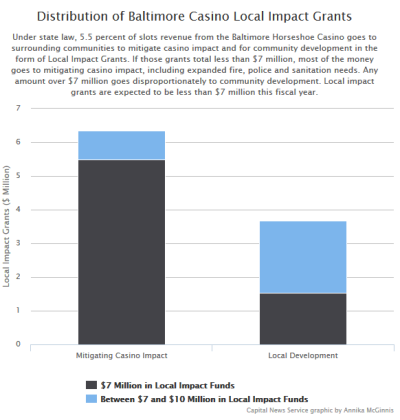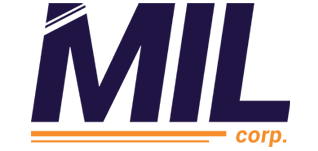
ANNAPOLIS — Maryland’s fifth casino, Horseshoe, debuted in Baltimore in August under a flurry of bells, whistles, and high expectations that it would create jobs, raise education funds and revitalize the state’s struggling economy.
But as initial revenues on the low end of projections are spurring debate about the casino’s financial potential, disputes are also brewing in impoverished Baltimore neighborhoods over who should pay for the infrastructure improvements and police and fire needs that have spiked with the casino’s opening.
The casino, plopped right in the middle of impoverished South Baltimore, was supposed to inject new life into “historically ignored” communities mired with high crime and unemployment rates, poor health and lackluster housing.
The 5.5 percent of casino slots funds designated for “local impact” were expected to go toward boosting lagging communities — building local businesses and career centers, empowering youth, beautifying parks and bringing in healthy, fresh food to areas overrun with corner stores.
But 78 percent of this year’s “impact” funding from Horseshoe — $5.5 million out of $7 million — will most likely go to mitigating casino needs, including increased police and emergency medical services, traffic enforcement, sanitation, security cameras and road work, according to the mayor’s proposed budget.
The other $1.5 million is going mostly to studies and needs assessments for future community projects, as well as an employment connection center and small grants for immediate neighborhood projects.
Horseshoe’s lower-than-expected earnings this fall also mean most proposed community projects for this fiscal year will be pushed to the next, including creating youth job and internship programs in a city where 9 percent of residents were unemployed on average this year.
Some local leaders of the six neighborhoods in the “impact zone” said initial hopes were too good to be true.
“I work in the Cherry Hill community. There are a lot of issues; there are a lot of issues that the casino could address,” said Baltimore neighborhood leader Michael Middleton. “We need to see some different signs of something good that’s coming from the casino to those communities.”
Casinos’ local impact has long sowed contention among state governments touting the benefits of gambling revenue, and some economists, sociologists and local leaders who say the gambling centers leech wealth out of communities and foster expensive and unhealthy gambling addictions in often-impoverished groups.
Over the next two years, relocating a steam pipe that some consider a public safety problem from beneath the casino will take $3 million out of impact grants. Both the pipe’s contractor, Veolia Transportation, and Caesars Entertainment Corp., which owns Horseshoe, refused to pay for the upgrade, state Sen. Bill Ferguson, chair of the Baltimore local development council that monitors impact funds, wrote in an August statement on his blog.
The casino will pay the city about $30 million over three years, which the mayor will use for reducing property taxes and constructing schools, Ferguson wrote. Caesars believed these payments required the city to construct “a site on which the facility could be built and operated safely,” he wrote.
Ferguson responded to resident concerns at the Oct. 30 meeting by insisting the spending plan balanced mitigating casino impacts with revitalizing communities.
The legislation that laid out casino funds’ distribution states the money can be used for “infrastructure improvements, facilities, public safety, sanitation, economic and community development … and other public services and improvements.”
Many initial costs “modernizing” the area will go away after the first few years, said Ethan Cohen, a project coordinator in Baltimore Mayor Stephanie Rawlings-Blake’s office.
But city agencies’ needs have skyrocketed since the casino’s opening — and the community-intended fund has absorbed the costs.
Fire services expand due to spike in EMS calls
Between the casino’s opening on Aug. 26 and Oct. 5, the Baltimore City Fire Department saw medical calls in the area increase more than 450 percent compared to same period last year, department statistics show.
Medic teams responded to 83 emergency medical service calls in those first 40 days versus 18 in the same period in 2013 and 23 in 2012. Seventy-seven calls within this year’s period were emergencies, including three suicides and three people struck by vehicles.
The spike in calls is consistent with more people in the area, said Mark Wagner, the fire department’s assistant chief of operations. The casino expects more than 5 million visitors a year, casino spokesman Dave Curley said.
The department will spend $300,000 of this fiscal year’s $7 million in impact funds on a new emergency medical services unit. The new engine cannot fit inside the firehouse, so part of the department’s $2.7 million request next year is for two firehouse renovations. It is also requesting another unit.
Eighteen police officers are also assigned to a new casino “mini-district,” and the city’s police department will receive at least $1.5 million by July for additional coverage in the area.
The spending trend is similar at the Maryland Live! casino in Hanover, where 54 percent of the $55.6 million in impact funds since fiscal year 2012 have gone to fire and police. About 1 percent, or $600,000, also funded community projects ranging from elementary school field trips to a grief support program, homeless “grooming” services, and hats and mittens for newborns.
Seventeen-year Baltimore resident Bill Marker said he understood people might “win $100,000 and have a heart attack,” but communities shouldn’t be tacked with the bill.
“If you decided to start a business that had major impact on things, you would be expected to bail the costs,” he said.
Horseshoe responded to concerns that the casino should be absorbing the extra costs by expressing their pride for “every penny” they contributed to “local impact funds, employee wages and city and state coffers.” As of Dec. 5, Horseshoe had raised $2.4 million in impact grants, according to the Maryland Lottery and Gaming Control Agency.
“While the casino does not dictate how money is allocated within the community, we are pleased that in just 100 days of operation our business is making a major contribution to the local economy through the creation of new jobs, new tax revenues and new funding for neighborhood projects,” Chad Barnhill, Horseshoe Casino senior vice president and general manager, said in a statement.
Falling casino revenue means less money for locals
Voters statewide approved building the Baltimore casino — the state’s second-largest, with 2,500 slot machines and 145 table games — in a 2008 constitutional referendum that also approved four other casinos.
Perryville’s Hollywood Casino opened in September 2010, then Berlin’s Ocean Downs in 2011, Hanover’s Maryland Live! in 2012, and Allegany’s Rocky Gap Casino Resort in 2013. The sixth, which got the green light in 2012, will open in 2016 in Prince George’s County’s National Harbor.
This fiscal year, which will end July 1, the casinos have raised $278.9 million, including $14.9 million in local impact grants, Maryland Lottery and Gaming Control Agency statistics show. But with overall drops in year-to-year casino revenue (excluding Horseshoe) this September, October and November compared to the same months last year, some question whether there’s still enough demand for gambling venues.
The Baltimore mayor’s office and neighborhood council had planned for lower and higher revenue levels by creating two “tiers” of possible impact grant spending.
But this fall’s lower-than-expected receipts at Horseshoe, about $22 million to $23 million each month, mean that yearly, the city will most likely only reach the lower “tier” — which prioritizes city agencies, putting community projects at the bottom.
In Baltimore, a fourth of people in 2012 already lived below the poverty line. A 2013 report by civil society think tank the Institute for American Values showed casinos typically weakened local businesses and slashed property values, and people living close by were more likely to become the “problem gamblers” casinos depend upon.
Around Horseshoe, traffic jams will likely increase, as will bankruptcies, divorce rates, drunken driving and people addicted to gambling, said economist Richard McGowan of the Harvard-affiliated Cambridge Health Alliance.
The casino responded by pointing to studies conducted by U.S. government agencies and universities in the late 1990s and early 2000s that showed casinos did not increase bankruptcy rates, street crime or social problems in surrounding neighborhoods.
Community-intended funds reallocated to city-led projects
One of the few planned community projects for the first year was a $500,000 fund to create a “community benefits district” that would give neighborhoods leeway in spending the money.
But lack of time to craft the district meant $300,000 of that pot was reallocated in October to jumpstarting small-scale projects the city can complete by July 1.
The city will decide on options including tree planting, re-striping crosswalks, painting a mural and installing streetlights, Cohen said. Each of the six neighborhoods will get $50,000.
Residents were concerned the city was “making decisions for every dime that’s spent.”
Stark wealth cleavages exist among the neighborhoods. Local development council member Keisha Allen was worried priorities of poorer areas, such as her Baltimore Westport neighborhood — including workforce development, GED programs and fixing vacant lots — would get pushed behind areas such as the Federal Hill neighborhood just blocks away, “where everyone has a decent job or a high school diploma.”
But mayor’s office representative Cohen said securing non-city-led services — including giving the neighborhoods control — would slow the process and make costs unpredictable.
As Baltimore leaders plan casino funding for the coming years, residents are hoping for “revival.”
In South Baltimore, “businesses have been boarded up for 40 years,” Allen said.
“We’re just kind of off the beaten path: out of sight, out of mind,” she said. “Now, we can get some things quicker. We need to figure it out, because we need to see something. We need to see change.”

